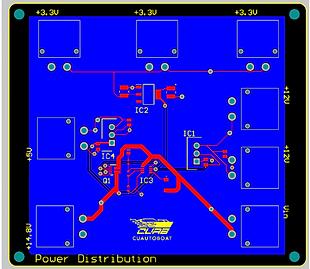Electrical Systems
E-Systems coordinate the flow of information and power between all the boat's components, by developing custom PCBs and implementing electrical infrastructure, serving as the vital bridge between hardware and software.
At the heart of E-Systems lies the power distribution board, which routes power at appropriate and precise voltage levels to our boat's low-power components including microcontrollers, our kill switch relay, and our transceiver. The board takes an input of 14.8V from our BlueRobotics Lithium-Ion battery, which is then routed through an input protection IC, ensuring that our sensitive components are not exposed to overvoltage or a surge of current. Next, voltage regulators step down the input voltage to 12V and 5V for the components mentioned above.

3D Model of our current power distribution board. IC1, IC2, and IC4 are voltage regulators while IC3 is a PMIC chip

2D PCB rendering of our current power distribution board
Another critical power system E-systems is responsible for is our killswitch, a needed safety feature for our high-power electronics. Our killswitch PCB features a two-form 45A/50A switching relay, which allows us to kill our thrusters and robotic motors with the press of a button. Additionally, when the kill button is pressed, a MOSFET is turned on, allowing current to flow from the drain to the source and sending a 5V signal to our Arduino microcontroller, letting it know that the killswitch was activated.

3D Model of our current killswitch board featuring our two-form 45A/50A switching relay
Beyond power, E-Systems oversees communication, selecting and implementing transceivers and microcontrollers. These devices facilitate remote control capabilities, and ensure that all of the intricate control pathways between the computer and the motors are operating smoothly.
E-Systems is also responsible for facilitating WiFi communication with our on-shore control system. Our custom power over ethernet PCB gives our mounted bullet antenna power, and transfers data to our main on-board computer.

